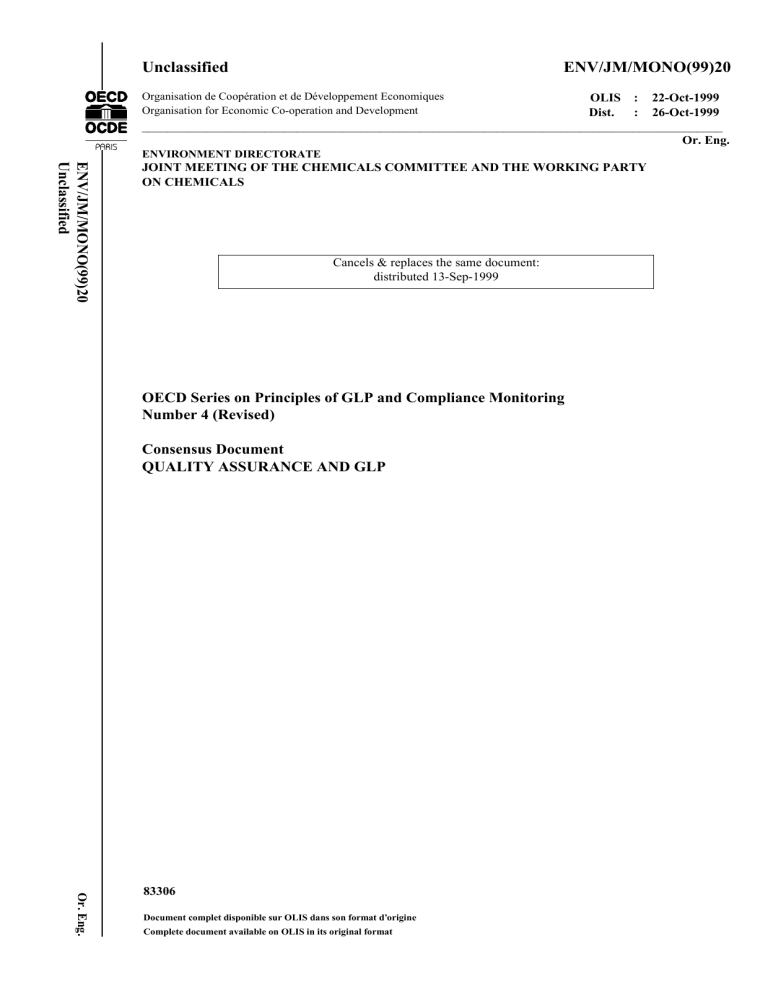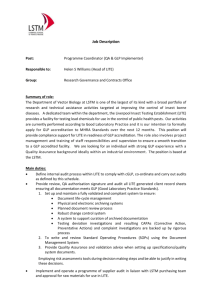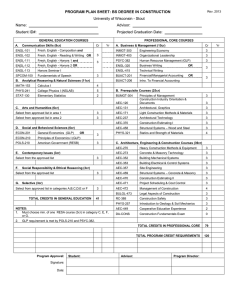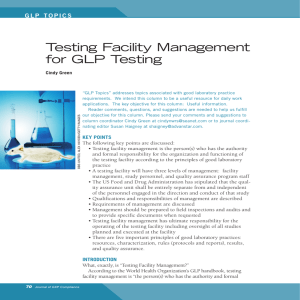Quality Assurance and GLP

Unclassified ENV/JM/MONO(99)20
Organisation de Coopération et de Développement Economiques
Organisation for Economic Co-operation and Development
OLIS : 22-Oct-1999
Dist. : 26-Oct-1999
__________________________________________________________________________________________
Or. Eng.
ENVIRONMENT DIRECTORATE
JOINT MEETING OF THE CHEMICALS COMMITTEE AND THE WORKING PARTY
ON CHEMICALS
Cancels & replaces the same document: distributed 13-Sep-1999
OECD Series on Principles of GLP and Compliance Monitoring
Number 4 (Revised)
Consensus Document
QUALITY ASSURANCE AND GLP
83306
Document complet disponible sur OLIS dans son format d’origine
Complete document available on OLIS in its original format
ENV/JM/MONO(99)20
2
ENV/JM/MONO(99)20
REVISED CONSENSUS DOCUMENT
OECD SERIES
ON
PRINCIPLES OF GOOD LABORATORY PRACTICE AND COMPLIANCE MONITORING
Number 4 (revised)
GLP Consensus Document
QUALITY ASSURANCE AND GLP
Environment Directorate
ORGANISATION FOR ECONOMIC CO-OPERATION AND DEVELOPMENT
Paris 1999
3
ENV/JM/MONO(99)20
FOREWORD
In the framework of the OECD Consensus Workshop on Good Laboratory Practice, held 16th-18th
October 1990 in Bad Dürkheim, Germany, a Working Group met to discuss and arrive at consensus on Good
Laboratory Practice and the role of quality assurance (QA). The Working Group was chaired by Dr. Hans
Könemann (Head, GLP Compliance Monitoring Authority, the Netherlands). Participants were mainly members of national GLP compliance monitoring units or experienced QA managers from test facilities. The following countries were represented: Austria, Belgium, France, Germany, Ireland, the Netherlands, Norway,
Spain, Sweden, Switzerland, and the United Kingdom.
The Working Group reached consensus on the role of QA as an important component of GLP. It identified major issues related to QA and GLP, but did not attempt to treat the subject exhaustively. One area not specifically addressed was the application of QA to field studies. This and some other aspects of QA will be addressed separately.
The draft consensus document developed by the Working Group was circulated to Member countries and revised, based on the comments received. It was subsequently endorsed by the OECD Panel on
GLP, and the Chemicals Group and Management Committee of the Special Programme on the Control of
Chemicals. The Environment Committee then recommended that this document be derestricted under the authority of the Secretary-General.
In light of the adoption of the Revised OECD Principles of GLP in 1997, this Consensus Document was reviewed by the Working Group on GLP and revised to make it consistent with modifications made to the Principles. It was endorsed by the Working Group in April 1999 and, subsequently by the Joint Meeting of the Chemicals Committee and Working Party on Chemicals, Pesticides and Biotechnology in August
1999. It too is declassified under the authority of the Secretary-General.
4
ENV/JM/MONO(99)20
GLP CONSENSUS DOCUMENT
QUALITY ASSURANCE AND GLP
Background
The OECD Principles of GLP have been in force for over fifteen years (see No.1 in this OECD
Series on Good Laboratory Practice and Compliance Monitoring, as revised in 1997). Valuable experience has been gained at test facilities where these principles have been applied, as well as by governmental bodies monitoring for compliance. In light of this experience, some additional guidance can be given on the role and operation of quality assurance programmes in test facilities.
References to Quality Assurance in the OECD Principles of GLP
A quality assurance programme is defined in the Revised OECD Principles of Good Laboratory
Practice as "a defined system, including personnel, which is independent of study conduct and is designed to assure test facility management of compliance with these Principles of Good Laboratory Practice" [Section
I.2.2(8)]. The responsibilities of the management of a test facility include ensuring "that there is a Quality
Assurance Programme with designated personnel and assure that the quality assurance responsibility is being performed in compliance with these Principles of Good Laboratory Practice" [Section II.1.1(2f)]. In addition the test facility management should ensure "that the Study Director has made the approved study plan available to the Quality Assurance personnel" [Section II.1.1(2j)] and the responsibility of the Study Director should include ensuring "that the Quality Assurance personnel have a copy of the study plan and any amendments in a timely manner and communicate effectively with the Quality Assurance personnel as required during the conduct of the study" [Section II.1.2(2b)]. The test facility management should also ensure that “for a multi-site study that clear lines” of communication exist between the Study Director,
Principal Investigator(s), the Quality Assurance Programme(s) and study personnel [Section II.1.1(2o)].
In section II.2 ("Quality Assurance Programme") the following requirements are listed:
2.1
General
1.
The test facility should have a documented Quality Assurance Programme to assure that studies performed are in compliance with these Principles of Good Laboratory Practice.
5
ENV/JM/MONO(99)20
2.
The Quality Assurance Programme should be carried out by an individual or by individuals designated by and directly responsible to management and who are familiar with the test procedures.
3.
This individual(s) should not be involved in the conduct of the study being assured.
2.2
Responsibilities of the Quality Assurance Personnel
1.
The responsibilities of the Quality Assurance personnel include, but are not limited to, the following functions. They should: a) maintain copies of all approved study plans and Standard Operating Procedures in use in the test facility and have access to an up-to-date copy of the master schedule; b) verify that the study plan contains the information required for compliance with these Principles of Good Laboratory Practice. This verification should be documented; c) conduct inspections to determine if all studies are conducted in compliance with these Principles of Good Laboratory Practice. Inspections should also determine that study plans and Standard Operating Procedures have been made available to study personnel and are being followed.
Inspections can be of three types as specified by Quality Assurance Programme
Standard Operating Procedures:
Records of such inspections should be retained.
d) inspect the final reports to confirm that the methods, procedures, and observations are accurately and completely described, and that the reported results accurately and completely reflect the raw data of the studies; e) promptly report any inspection results in writing to management and to the Study
Director, and to the Principal Investigator(s) and the respective management, when applicable; f) prepare and sign a statement, to be included with the final report, which specifies types of inspections and their dates, including the phase(s) of the study inspected, and the dates inspection results were reported to management and the Study
Director and Principal Investigator(s), if applicable. This statement would also serve to confirm that the final report reflects the raw data.
6
ENV/JM/MONO(99)20
In section II.7.4.5 the "operation of Quality Assurance personnel in planning, scheduling, performing, documenting and reporting inspections" is one of the categories of laboratory activities for which
Standard Operating Procedures (SOPs) should be available.
In section II.9.2.4. a final study report is required to include "a Quality Assurance Programme statement listing the types of inspections made and their dates, including the phase(s) inspected, and the dates any inspection results were reported to management and to the Study Director and Principal Investigator(s), if applicable. This statement would also serve to confirm that the final report reflects the raw data".
Finally, in section II.10.1(b) "records of all inspections performed by the Quality Assurance
Programme, as well as master schedules" should be retained in the archives for the period specified by the appropriate authorities.
The QA-management link
Management of a test facility has the ultimate responsibility for ensuring that the facility as a whole operates in compliance with GLP Principles. Management may delegate designated control activities through the line management organisation, but always retains overall responsibility. An essential management responsibility is the appointment and effective organisation of an adequate number of appropriately qualified and experienced staff throughout the facility, including those specifically required to perform QA functions.
The manager ultimately responsible for GLP should be clearly identified. This person’s responsibilities include the appointment of appropriately qualified personnel for both the experimental programme and for the conduct of an independent QA function. Delegation to QA of tasks which are attributed to management in the GLP Principles must not compromise the independence of the QA operation, and must not entail any involvement of QA personnel in the conduct of the study other than in a monitoring role. The person appointed to be responsible for QA must have direct access to the different levels of management, particularly to top level management of the test facility.
Qualifications of QA personnel
QA personnel should have the training, expertise and experience necessary to fulfil their responsibilities. They must be familiar with the test procedures, standards and systems operated at or on behalf of the test facility.
Individuals appointed to QA functions should have the ability to understand the basic concepts underlying the activities being monitored. They should also have a thorough understanding of the Principles of GLP.
In case of lack of specialized knowledge, or the need for a second opinion, it is recommended that the QA operation ask for specialist support. Management should also ensure that there is a documented training programme encompassing all aspects of QA work. The training programme should, where possible, include on-the-job experience under the supervision of competent and trained staff. Attendance at in-house and external seminars and courses may also be relevant. For example, training in communication techniques and conflict handling is advisable. Training should be continuous and subject to periodic review.
The training of QA personnel must be documented and their competence evaluated. These records should be kept up-to-date and be retained.
7
ENV/JM/MONO(99)20
QA involvement in developing SOPs and study plans
Management is responsible for ensuring that Standard Operating Procedures (SOPs) are produced, issued, distributed and retained. QA personnel are not normally involved in drafting SOPs; however it is desirable that they review SOPs before use in order to assess their clarity and compliance with GLP
Principles.
Management should ensure that the study plan is available to QA before the experimental starting date of the study. This allows QA:
to monitor compliance of the study plan with GLP;
to assess the clarity and consistency of the study plan;
to identify the critical phases of the study; and
to plan a monitoring programme in relation to the study.
As and when amendments are made to the study plan, they should be copied to QA to facilitate effective study monitoring.
QA inspections
QA programmes are frequently based upon the following types of inspections:
Study-based inspections: These are scheduled according to the chronology of a given study, usually by first identifying the critical phases of the study.
Facility-based inspections: These are not based upon specific studies, but cover the general facilities and activities within a laboratory (installations, support services, computer system,
training, environmental monitoring, maintenance, calibration, etc.).
Process-based inspections: Again these are performed independently of specific studies. They are conducted to monitor procedures or processes of a repetitive nature and are generally performed on a random basis. These inspections take place when a process is undertaken very frequently within a laboratory and it is therefore considered inefficient or impractical to undertake study-based inspections. It is recognised that performance of process-based inspections covering phases which occur with a very high frequency may result in some studies not being inspected on an individual basis during their experimental phases.
QA planning and justification of QA activities and methods
QA should plan its work properly and its planning procedures as well as the operation of QA personnel in performing, documenting and reporting inspections should be described in SOPs. A list of studies planned and in progress should be kept. QA should have access to an up-to-date copy of the master schedule. Such a list is necessary for planning QA activities and assessing the QA workload in the laboratory.
As is the case for any other operative procedures covered by the GLP Principles, the QA programme of inspections and audits should be subject to management verification. Both the QA
8
ENV/JM/MONO(99)20 staff and management should be able to justify the methods chosen for the performance of their tasks.
QA inspection reports
National GLP monitoring authorities may request information relating to the types of inspections and their dates, including the phase(s) of the study inspected. However, QA inspection reports should not normally be examined for their contents by national monitoring authorities as this may inhibit QA when preparing inspection reports. Nevertheless, national monitoring authorities may occasionally require access to the contents of inspection reports in order to verify the adequate functioning of QA. They should not inspect such reports merely as an easy way to identify inadequacies in the studies carried out.
Audits of data and final reports
The review of a study’s raw data
1
by QA can be carried out in a number of ways. For example, the records may be examined by QA during experimental phases of the study, during process inspections or during audits of final reports. Management should ensure that all final reports for which GLP compliance is claimed are audited by QA. This audit should be conducted at the final draft stage, when all raw data have been gathered and no more major changes are intended.
The aims of the audit of the final report should be to determine whether:
the study was carried out in accordance with the study plan and SOPs;
the study has been accurately and completely reported;
the report contains all the elements required by GLP;
the report is internally consistent; and
the raw data are complete and in compliance with GLP.
QA may find it helpful to record the audit of the final report in a form that is sufficiently detailed to enable the audit to be reconstructed. Procedures must be established so that QA is made aware of all additions or changes made to the study data and report during the audit phase.
Before signing the QA statement, QA should ensure that all issues raised in the QA audit have been appropriately addressed in the final report, that all agreed actions have been completed, and that no changes to the report have been made which would require a further audit.
Any correction of or addition to a completed final report must be audited by QA. A revised or additional QA statement would then need to be provided.
1
In the GLP Principles, raw data are defined as "all original test facility records and documentation, or verified copies thereof, which are the result of the original observations and activities in a study”. Raw data also may include, for example, photographs, microfilm or microfiche copies, computer readable media, dictated observations, recorded data from automated instruments, or any other data storage medium, that has been recognised as capable of providing secure
storage of information for a time period as stated in section 10 below." [Section I.2.3(7)].
9
ENV/JM/MONO(99)20
The QA statement
The Principles of GLP require that a signed quality assurance statement be included in the final report, which specifies types of inspections and their dates, including the phase(s) of study inspected, and the dates inspections results were reported to management and the Study Director and the Principal
Investigator(s), if applicable [Sections II.2.2(1f) and II.9.2(4)]. Procedures to ensure that this statement reflects QA’s acceptance of the Study Director’s GLP compliance statement and is relevant to the final study report as issued are the responsibility of management.
The format of the QA statement will be specific to the nature of the report. It is required that the statement include full study identification and the dates and phases of relevant QA monitoring activities.
Where individual study-based inspections have not been part of the scheduled QA programme, a statement detailing the monitoring inspections that did take place must be included, for example, in the case of shortterm studies where repeated inspections for each study are inefficient or impractical.
It is recommended that the QA statement only be completed if the Study Director’s claim to GLP compliance can be supported. The QA statement would also serve to confirm that the final report reflects raw data. It remains the Study Director’s responsibility to ensure that any areas of non-compliance with the GLP
Principles are identified in the final report.
QA and non-regulatory studies
Compliance with GLP is a regulatory requirement for the acceptance of certain studies. However, some test facilities conduct in the same area studies which are and which are not intended for submission to regulatory authorities. If the non-regulatory studies are not conducted in accordance with standards comparable to GLP, this will usually have a negative impact on the GLP compliance of regulatory studies.
Lists of studies kept by QA should identify both regulatory and non-regulatory studies to allow a proper assessment of work load, availability of facilities and possible interferences. QA should have access to an up-to-date copy of the master schedule to assist them in this task. It is not acceptable to claim GLP compliance for a non-GLP study after it has started. If a GLP-designated study is continued as a non-GLP study, this must be clearly documented.
QA at small test facilities
At small test facilities it may not be practicable for management to maintain personnel dedicated solely to QA. However, management must give at least one individual permanent, even if part-time, responsibility for co-ordination of the QA function. Some continuity in the QA staff is desirable to allow the accumulation of expertise and to ensure consistent interpretation. It is acceptable for individuals involved in studies that comply with GLP to perform the QA function for GLP studies conducted in other departments within the test facility. It is also acceptable for personnel from outside the test facility to undertake QA functions if the necessary effectiveness required to comply the GLP principles can be ensured.
This concept may be additionally applied to multi-site studies, for example field studies, on the condition that overall responsibility for co-ordination is clearly established.
10



